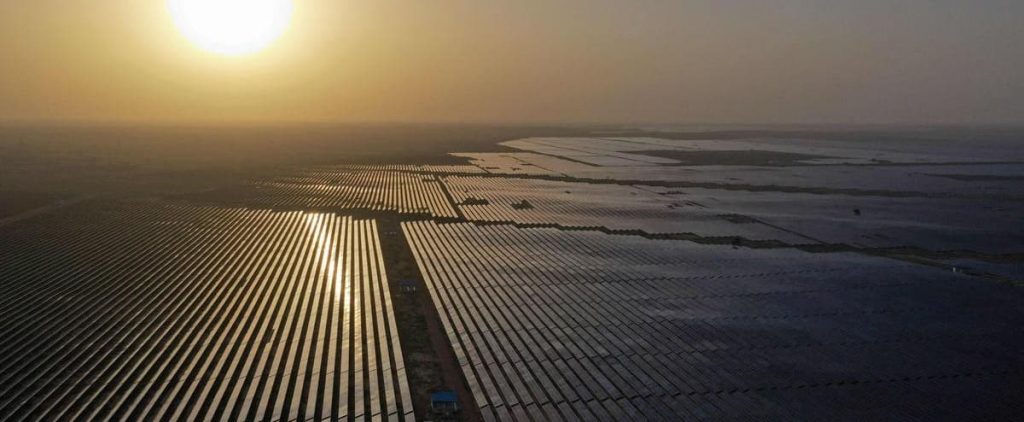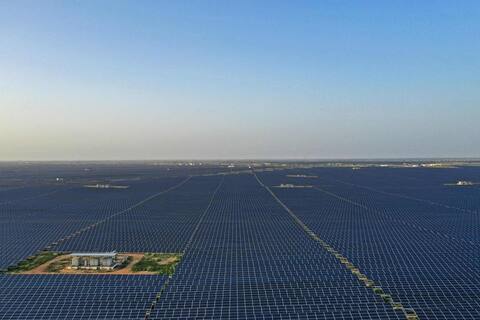
Bhadla, India | Behind the camels grazing dry grass on the edge of the Thar Desert, an oasis of cobalt blue photovoltaic panels stretches as far as the eye can see. Bhadla’s giant solar farm is a key part of India’s plan to become a champion of pure energy.
Also read: In Iceland, CO2 is removed from the air and turned to stone
India is currently the third largest emitter of carbon in the world. 70% of its electricity comes from coal-fired power stations.
However, Prime Minister Narendra Modi on Monday announced that the country would increase its share of renewable energy from 100 gigawatts (GW) to 500 GW by 2030, more than current power generation. By that date, 50% of the country’s energy must be clean, he assured, adding that by 2070 India will be targeting carbon neutrality.
With an area similar to the Republic of San Marino, Bhadla Farm is located in the desert state of Rajasthan. With 325 days of sunshine a year, this is the perfect place to start this Indian energy revolution.
The project is presented by its promoters as a model of high technology, innovation and public-private collaboration.
In Rajasthan, “We have large areas where grass does not grow. Now we cannot see the earth: we can only see the solar panels. He welcomed Subodh Agarwal, one of the energy policy makers of the “desert state” nicknamed Rajasthan.
“Solar State”
In the coming decade, “Rajasthan will be different. It will be the solar state of Rajasthan, ”he encouraged.
The formation of boulders in the middle of the desert had the least impact on human settlements and agriculture. Hundreds of people watch the installations, but these are robots that remove dust and sand from 10 million photovoltaic panels.
Other mega projects are ongoing. In Gujarat, Narendra Modi last year, in another desert, began construction of a Singapore-sized renewable energy park. Many of India’s richest men, such as Mukesh Ambani and Gautam Adani, the richest men in Asia, have begun to invest heavily in the sector.
It is imperative: According to a report published in 2019, 21 of the 30 most polluted cities in the world are in India alone. The country with a population of 1.3 billion with rampant urbanization is greedy for power.
The International Energy Agency (IEA) predicts that in the next 20 years, India will need to add capacity equivalent to Europe to its existing power generation system to meet skyrocketing domestic demand. And if India’s renewable energy capabilities have increased fivefold in the last decade, they need to more than double to reach the 500 GW target by 2030.
Vinay Rustagi, director of Bridge to India, a renewable energy consultancy, expressed skepticism. According to him, the Indian government is trying to “show the world that we are on the right path” above all else.
“Unfortunately, I believe we have no way to achieve this goal,” he lamented.
Rebuilding the energy system
Although installing solar panels is relatively inexpensive, experts warn that a lot of time and effort is still needed to fundamentally fix the Indian energy system.
Therefore, at present, almost 80% of the panels are imported from China and the national production capacities are not quite adequate.
And if iconic solar energy projects like Bhadla are successful, they will eventually run against land acquisition issues and more lawsuits from landowners who have been landlocked.
Therefore some experts believe that the future of solar energy in India will depend on the multiplication of small production units.
As set up by doctor and farmer Amit Singh in Bhaloji village in Rajasthan.
As the village was repeatedly plagued with power cuts and water shortages, Dr. Singh had an idea. “I always saw the sun and its rays and I asked myself: why not control it to generate electricity? He told the AFP.
He started by installing photovoltaic panels on the roof of his dispensary, which covered half of the installation’s electrical needs. He used his savings to set up a megawatt power plant on his small family farm.
The cost of this mini solar power plant is 35 million rupees (approximately $ 550,000). An investment that proves to be profitable in a reasonable period of time from each month, bringing about Rs 400,000 (approximately $ 6,000) in sales to the Indian power grid. “I feel like I am contributing to the development of my village,” Mr Singh said.
Arunabha Ghosh, an expert in climate policy with the Energy, Environment and Water Council, said it was important to reduce the cost of such small installations.
“When a farmer is able to generate electricity using a solar power station near his farm and pump water, a rural resident can run a textile factory using solar panels placed on the roof so that we can bring energy conversion closer to the people. , “He said.








More Stories
Scotiabank customers can't get their pay: “We've fixed the problem”
His wife was badly beaten at CHSLD
Here is my response to Minister Pierre Fitzgibbon's insult about the school tax